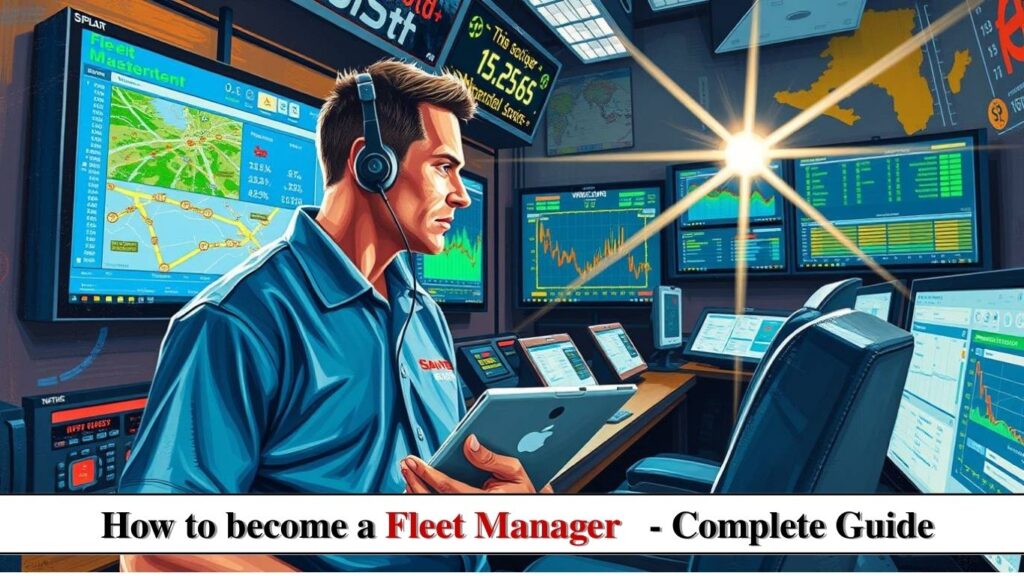
Introduction
In our increasingly mobile world, efficient vehicle fleet management is the backbone of transportation, logistics, and delivery services. Fleet Managers play a critical role in optimizing vehicle operations, reducing costs, and ensuring regulatory compliance across industries.
If you’re passionate about transportation, operations management, and data-driven decision making, a career as a Fleet Manager offers stability and growth potential. This comprehensive guide covers:
- The Evolution of Fleet Management
- Key Roles & Responsibilities
- 2024 Salary Benchmarks Worldwide
- Essential Qualifications & Certifications
- Step-by-Step Career Path
- Future Trends & Industry Outlook
Let’s shift into gear and explore this vital profession!
History of Fleet Management
Fleet management has evolved from simple vehicle maintenance to sophisticated telematics-powered optimization systems.
Key Historical Milestones:
- Early 1900s: Basic vehicle maintenance for industrial and military fleets
- 1950s: Introduction of preventive maintenance schedules
- 1980s: Computerized Maintenance Management Systems (CMMS) emerge
- 1990s: GPS technology enables real-time vehicle tracking
- 2000s: Telematics systems integrate GPS, diagnostics, and driver behavior monitoring
- 2010s-Present: AI-powered predictive maintenance and EV fleet management revolutionize the field
Today’s fleet managers use IoT sensors, big data analytics, and automation to optimize operations.
Roles & Responsibilities of a Fleet Manager
Fleet Managers serve as strategic operators overseeing all aspects of vehicle operations.
Core Responsibilities:
- Vehicle Acquisition & Disposal
- Select appropriate vehicle types/models for operational needs
- Manage leasing vs. purchasing decisions
- Oversee vehicle remarketing/sales
- Maintenance Management
- Implement preventive maintenance programs
- Coordinate with service providers and repair shops
- Manage warranty claims and recalls
- Fuel Management
- Monitor fuel consumption and costs
- Implement fuel card programs
- Develop eco-driving initiatives
- Compliance & Safety
- Ensure adherence to DOT, OSHA, and EPA regulations
- Manage driver qualification files
- Oversee safety training programs
- Technology Implementation
- Deploy and manage telematics systems
- Utilize fleet management software
- Implement EV charging infrastructure
- Cost Control & Budgeting
- Analyze total cost of ownership (TCO)
- Identify cost-saving opportunities
- Prepare annual fleet budgets
Industries Hiring Fleet Managers:
- Logistics & Transportation
- Construction
- Public Transit
- Rental Car Companies
- Food & Beverage Distribution
- Emergency Services
Fleet Manager Salary (2024)
Salaries vary based on fleet size, industry, and location.
Global Salary Benchmarks:
| Country | Entry-Level | Mid-Career | Senior-Level |
|---|---|---|---|
| USA | $55,000 | $75,000 | $100,000+ |
| UK | £30,000 | £45,000 | £60,000+ |
| UAE | AED 120,000 | AED 180,000 | AED 250,000+ |
| India | ₹5 LPA | ₹10 LPA | ₹15 LPA+ |
Top Paying Industries:
- Oil & Gas
- Mining
- Airlines (Ground Fleet)
- Large Logistics Providers
Qualifications & Skills Required
Educational Background:
- Bachelor’s Degree in:
- Logistics/Supply Chain Management
- Business Administration
- Automotive Engineering
- Transportation Management
Certifications to Boost Your Career:
✔ Certified Automotive Fleet Manager (CAFM)
✔ DOT Compliance Certification
✔ ASE Maintenance & Light Repair Certification
✔ Telematics Specialist Certification
Technical Skills:
- Fleet Management Software (Geotab, Samsara)
- Telematics Systems
- Advanced Excel (Pivot Tables, Macros)
- Basic Vehicle Mechanics Knowledge
- Regulatory Compliance (DOT, IFTA)
Soft Skills:
✔ Problem-Solving
✔ Leadership
✔ Communication
✔ Negotiation
✔ Data Analysis
How to Become a Fleet Manager (Step-by-Step)
Step 1: Build Educational Foundation
- Earn relevant degree (Logistics, Business, or Engineering)
- Take online courses in fleet management
Step 2: Gain Industry Experience
- Start in entry-level positions:
- Dispatcher
- Logistics Coordinator
- Maintenance Technician
Step 3: Develop Technical Expertise
- Learn fleet management software
- Understand vehicle specifications and maintenance
Step 4: Earn Certifications
- Obtain CAFM certification
- Complete DOT compliance training
Step 5: Build Management Skills
- Take on supervisory roles
- Develop budgeting and reporting skills
Step 6: Apply for Fleet Manager Positions
- Highlight cost-saving achievements
- Emphasize safety and compliance experience
Future Scope of Fleet Management
The global fleet management market is projected to reach $52.5 billion by 2030 (Allied Market Research).
Emerging Trends:
⚡ Electric Vehicle Fleet Transition
🤖 Autonomous Vehicle Integration
📊 AI-Powered Predictive Maintenance
🌱 Sustainability Initiatives
📱 Mobile-First Fleet Management
Job Growth Outlook:
- Steady growth expected as e-commerce expands
- High demand for EV and sustainability experts
- Technology skills becoming essential
Conclusion
A career as a Fleet Manager offers stable growth opportunities in an essential industry that’s undergoing technological transformation.
Key Takeaways:
✅ Combine technical knowledge with management skills
✅ Stay current with EV and telematics trends
✅ Develop data analysis capabilities
✅ Build regulatory expertise
The road ahead is clear – skilled Fleet Managers will be crucial in navigating the future of transportation.
By following this comprehensive roadmap, you’ll be well-equipped to start and grow your career in this dynamic field! 🚛💨













Post Comment